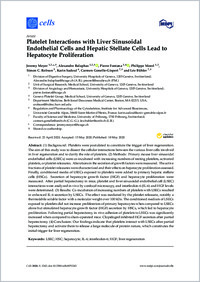Platelet interactions with liver sinusoidal endothelial cells and hepatic stellate cells lead to hepatocyte proliferation
- Meyer, Jeremy Division of Digestive Surgery, University Hospitals of Geneva, 1205 Genève, Switzerland - Unit of Surgical Research, Medical School, University of Geneva, 1205 Genève, Switzerland
- Balaphas, Alexandre Division of Digestive Surgery, University Hospitals of Geneva, 1205 Genève, Switzerland - Unit of Surgical Research, Medical School, University of Geneva, 1205 Genève, Switzerland
- Fontana, Pierre Division of Angiology and Hemostasis, University Hospitals of Geneva, 1205 Genève, Switzerland - Geneva Platelet Group, Medical School, University of Geneva, 1205 Genève, Switzerland
- Morel, Philippe Division of Digestive Surgery, University Hospitals of Geneva, 1205 Genève, Switzerland - Unit of Surgical Research, Medical School, University of Geneva, 1205 Genève, Switzerland
- Robson, Simon C. Department Medicine, Beth Israel Deaconess Medical Center, Boston, MA 02215, USA
- Sadoul, Karin Regulation and Pharmacology of the Cytoskeleton, Institute for Advanced Biosciences, Université Grenoble Alpes, 38400 Saint-Martin-d’Herès, France
- Gonelle-Gispert, Carmen Faculty of Science and Medicine, University of Fribourg, 1700 Fribourg, Switzerland
- Bühler, Leo Faculty of Science and Medicine, University of Fribourg, 1700 Fribourg, Switzerland
-
18.05.2020
Published in:
- Cells. - 2020, vol. 9, no. 5, p. 1243
English
Background: Platelets were postulated to constitute the trigger of liver regeneration. The aim of this study was to dissect the cellular interactions between the various liver cells involved in liver regeneration and to clarify the role of platelets. (2) Methods: Primary mouse liver sinusoidal endothelial cells (LSECs) were co-incubated with increasing numbers of resting platelets, activated platelets, or platelet releasates. Alterations in the secretion of growth factors were measured. The active fractions of platelet releasates were characterized and their effects on hepatocyte proliferation assessed. Finally, conditioned media of LSECs exposed to platelets were added to primary hepatic stellate cells (HSCs). Secretion of hepatocyte growth factor (HGF) and hepatocyte proliferation were measured. After partial hepatectomy in mice, platelet and liver sinusoidal endothelial cell (LSEC) interactions were analyzed in vivo by confocal microscopy, and interleukin-6 (IL-6) and HGF levels were determined. (3) Results: Co-incubation of increasing numbers of platelets with LSECs resulted in enhanced IL-6 secretion by LSECs. The effect was mediated by the platelet releasate, notably a thermolabile soluble factor with a molecular weight over 100 kDa. The conditioned medium of LSECs exposed to platelets did not increase proliferation of primary hepatocytes when compared to LSECs alone but stimulated hepatocyte growth factor (HGF) secretion by HSCs, which led to hepatocyte proliferation. Following partial hepatectomy, in vivo adhesion of platelets to LSECs was significantly increased when compared to sham-operated mice. Clopidogrel inhibited HGF secretion after partial hepatectomy. (4) Conclusion: Our findings indicate that platelets interact with LSECs after partial hepatectomy and activate them to release a large molecule of protein nature, which constitutes the initial trigger for liver regeneration
- Faculty
- Faculté des sciences et de médecine
- Department
- Master en médecine
- Language
-
- English
- Classification
- Biological sciences
- License
-
License undefined
- Identifiers
-
- RERO DOC 328642
- DOI 10.3390/cells9051243
- Persistent URL
- https://folia.unifr.ch/unifr/documents/308750
Statistics
Document views: 140
File downloads:
- pdf: 201
